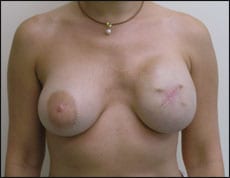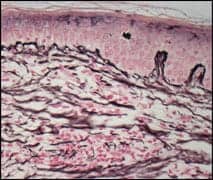In the often very complex process of breast reconstruction, one of the final tasks for the surgeon is the creation of the nipple-areolar complex. There is no single best method of nipple reconstruction for all patients, but should the patient want a nipple then there are some tried-and-true surgical and nonsurgical options.
For the areola, some patients choose the nonsurgical option of tattooing without reconstruction. This allows color pigmentation to simulate the nipple areola without the contour of an actual nipple. On the surgical side, the actual reconstruction of the nipple areola helps to put the finishing touches on the new breast after a long journey in reconstruction.
Historically, one technique that was used for many years but has been discontinued is to share a portion of the nipple from the opposite breast. Another disused technique was to graft tissue from the labia to the breast.
According to Jane Petro, MD, a cosmetic surgeon based in Boston, the nipple mound is created from skin taken as a local flap on the reconstructed breast. Various local flaps have been described in the literature, including the C-V flap, the Star flap, and the Skate flap.
The areola can then be either tattooed or reconstructed with a skin graft taken from elsewhere on the body, usually the medial thigh; or, if a contralateral reduction is being done, areolar sharing can be done. Other common donor sites for the graft include the abdominal scar “dog ear” from a flap reconstruction donor site or the buttock.
Recently, PSP spoke with Petro about the options that she uses for nipple reconstruction, as well as some of the concerns that come with the procedure and the evolution of these surgical techniques.
 |
| Figure 1. In this unilateral breast reduction, we see a little bit of bleeding around and an irregularity in the areola. PHOTOS COURTESY OF JANE PETRO, MD |
PSP: What is your preferred technique for nipple reconstruction?
Petro: Most commonly, I use a “star” or “skate” flap for the nipple reconstruction unless there is excess scar in the area, in which case either a dermal auto or allo graft can be used to create the projection. For the areola, if the patient is having a bilateral reconstruction, a tattoo or a full-thickness graft taken from the inner groin area can recreate the pigmented appearance of the areola.
PSP: What types of patients are good candidates for this procedure?
Petro: Any patient who has lost the nipple or the nipple areola complex, whether from cancer surgery like a mastectomy or local resections for infection which can follow nipple piercing rarely. Occasionally, the patient may lose the nipple-aroelar complex following a reduction. Then there are people with skin cancers like melanoma, basal cell, or Paget’s disease—they are all candidates for breast reconstruction. Matching the opposite nipple requires precise measurements, and care in pigment matching. If the procedure is a bilateral reconstruction, it is easier to get a good match.
PSP: Are there any side effects or dangers associated with this procedure?
Petro: The principal complication is failure of the nipple to maintain projection—about 50% of the time—and in a tattooed areola the nipple will lose pigment and fade over time.
Minor complications like infection can occur and would jeopardize the implant if that was used for reconstruction, but that would be quite unusual. Of course, using a needle in the vicinity of an implant requires some care to avoid rupturing the implant, but usually the procedure is much more superficial and doesn’t place the implant at risk.
PSP: What preprocedural and postprocedural regimens do you ask your patients to follow?
Petro: Preoperatively, patients are asked to shower with an antiseptic soap. The postoperative regimen is just routine wound care, dressing changes starting 3 days after the procedure for nipple reconstruction and 1 day later for tattooing, or a bolster dressing removed after 7 days if a graft is used.
Many physicians recommend a nipple guard to be used for several weeks post-surgery because they believe it reduces the risk of nipple collapse.
PSP: There are different nipple reconstruction techniques that are offered to patients. What factors help determine the type of method that is right for your patients?
Petro: In the past, nipples have been reconstructed with ear cartilage and skin grafts, a variety of local flaps, or grafts taken from incisional dog ears. Many years ago, the nipple-areolar complex was removed from the mastectomy specimen and “banked” by grafting in the groin area, typically doing a reconstruction 1 or more years later. This was unsatisfactory as projection was lost, and there was about a 1% incidence of cancer arising in the nipple.
There are new indications for preserving the nipple-areolar complex using simple mastectomy, avoiding the need for reconstruction. I have been using local skin flaps preferentially for about 15 years. I do immediate nipple reconstruction at the time of tram or LD flap reconstruction, especially if a skin-sparing mastectomy has been done. The flap itself fills the areolar defect, and making the nipple gives the patient a near-normal appearance on the same day as the cancer and reconstructive surgery. The flap skin can be tattooed within a couple of weeks, making the overall recovery time quite short.
 |
 |
| Figure 2. This patient has had a staged breast reconstruction, which shows the nipple reconstruction technique very nicely. The right breast has been reduced, and the left breast has been reconstructed. | |
PSP: How long does it typically take for the stitches to dissolve and the discoloration to disappear?
Petro: Stitches can be removed between 5 and 14 days; or, a variety of buried or dissolving sutures can be used. Bruising can occur but is usually gone in less than 2 weeks. Color in a graft gets better over time. Tattoos begin to fade over a period of years and may need touch-ups periodically.
PSP: What are the pros and cons of nipple areola tattooing versus nipple reconstruction?
Petro: Tattooing provides a simple method of areolar reconstruction, but it may be difficult to match an opposite native areola. I let patients choose, in most cases. Some patients have strong social or religious beliefs against tattoos and prefer a graft. For other patients, the pain of the graft donor site is undesired and tattooing is preferred.
PSP: Were one to develop new techniques in this area, what would you like to see?
Petro: Well, there’s no way you can make a functional nipple. What you could see is an aesthetic nipple with the proper projection and pigment of the technical areola. What the successful nipple reconstruction is missing is providing sensation to the nipple-areola complex. There has been some remote work done on that—I’m thinking of the work of Caroline Kerrigan’s [MD] work on intercostal flaps to restore sensation to the nipple. But that’s rarely done.
The goal for nipple reconstruction is simply to give [the patient] a visually acceptable, symmetrical nipple areolar complex. It’s a complicated operation. Most people wouldn’t know how to do it; and most patients probably wouldn’t, Number 1, think to ask for it, and, Number 2, maybe want to go through with doing it.
The technical parts of this that are challenging are matching an opposite nipple if we’re only doing one, and/or locating the nipple in the appropriate space in relationship to the reconstructed breast—making sure that it maintains projection. Areola have an appearance of being relatively rounded, and although they are slightly oval they are not cookie cutter. And a real areola probably is not absolute symmetrical in its pigment, either. We tend to use either skin grafts harvested from the medial thigh, which tends to be nicely pigmented once it heals—or through a tattoo, which gives you a nice, uniform pigmentation.
PSP: Is the idea of restoring sensation to the real areola a futuristic goal?
Petro: Yes, very much so. The real forward-going goal is in maintaining nipple projection, and to use any techniques you have available to give it good aesthetic pigmentation.
Nipples range from almost flesh-colored, which fades right into the patient’s normal skin color, to quite dark—browns, blacks. Mixing the pigment prior to doing the tattoo is really fun. There’s not a lot of science to it. It’s one of those rare areas where still a fair amount of art involved.
The challenges come in patients who have had a lot of scarring or had a lot of radiation in the tissues. We have [seen] those kinds of damaged tissues, and it is almost impossible to get a good nipple reconstruction using these techniques.
I think future directions will be things like methods for reducing scarring and, as I said before, finding ways to maintain nipple projection. There are these gadgets called nipple cups—it is a bandage with a little bubble or cup at one end that fits over the nipple and makes sure nothing is pressing against the nipple during the postop recovery period. Some people feel that that protects the nipple and gives you a better result in the projection.
PSP: What about the use of stem cells as part of the reconstruction job?
Petro: We are already seeing benefits with stem cells in improving skin tone and texture. I can see where we could be using stem cells to ameliorate the damage to the tissues, in order to create a better bed for the reconstruction.
PSP: What about repairing poor reconstruction jobs?
Petro: That is where you get into some really significant challenges. First of all, define what the patient doesn’t like. One complaint is that the nipple projection doesn’t last, so the nipple gets flattened. The other thing is that you get bleeding of the tattoo pigments, so that the edges are ill-defined or there are significant irregularities in the areola itself.
So, you revive it and do some cosmetic changes but you are working in scar tissue, which already is difficult.
PSP: Patients with that problem may have a problem that lasts. What do you do to prepare them mentally and emotionally for that?
Petro: It’s the same as with any informed consent. I would talk with the patient to make sure that they have reasonable expectations.
PSP: What about pain management during the recovery process?
Petro: This is a very straightforward minor surgical procedure, so the vast majority of them are done as an outpatient procedure under local anesthesia. To do the flap itself takes maybe 30 minutes. When I’ve done tattooing, I don’t offer the patient any pain medication because the process is relatively painless. I might give a mile narcotic for t areola reconstruction donet by graft harvesting from the thigh. Most patients find that quite uncomfortable for several days to weeks.. But if I do use the medial thigh, the patient will need ice applied locally and to wear loose undergarments to make sure the elastic from the panties doesn’t cut into the incision. That’s about the only time I will prescribe mild narcotic pain meds for nipple-areolar reconstruction.
Rima Bedevian is a contributing writer for PSP. She can be reached at [email protected].





